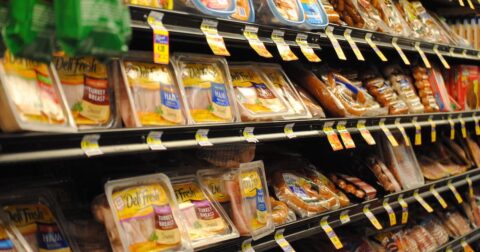Perspective
Critics Declared Veganism Dead in 2025. Here’s What Those Obituaries Are Missing.
Food•5 min read
Analysis
By not being upfront with consumers, labeling systems are making the industry seem like it is doing more than it actually is to improve animal welfare.


Words by Claire Hamlett
Picture a chicken. She is not in a cage, but in a barn, one she shares with thousands of other chickens. At nearly three kilograms, she is bulky and reached that size in five weeks. She has never been outdoors.
When she arrives on the shelf at the grocery store, she is shrink-wrapped and displayed with a label from an animal welfare certification scheme that gives minimal, if any, indication of the kind of life she led. But the packaging also displays words like “humane” or “humanely raised.” Since the product is certified, a shopper might take that to mean the chicken probably had a reasonably good life.
But there is little evidence to support this claim. A new report by U.S. nonprofit Farm Forward, called “The Dirt on Humanewashing,” accuses these animal welfare certification programs of confusing and duping consumers into buying animal products that do not meet their expectations of humane treatment of farm animals.
While it will come as no surprise to some that the bulk of animal products on grocery store shelves are produced under cruel and unhealthy conditions, meat sales continue to rise in the U.S. despite ample evidence of increasing concerns about animal welfare. The risk, claims Farm Forward’s report, is that by not being upfront with consumers, certifications are entrenching industrial animal agriculture by making the industry seem like it is doing more than it actually is to improve animal welfare. In this way, they “thwart the kinds of reforms necessary to phase out industrialized farming.”
Farm Forward’s Executive Director Andrew deCoriolis believes that certification programs are doing the public a disservice by obfuscating, through misleading or inadequate labeling, how most of their certified products are produced. “The public is ready to hear a message I think, that most animals are not raised in the conditions that they want them to be,” he told Sentient Media.
What expectations do consumers have about “humanely raised” meat? Farm Forward claims it is “well-attested in consumer surveys” that they expect it to mean “requiring animals to be raised on pasture.” But in fact, the research the report cites to back this up describes a lower threshold of consumer expectation for humaneness.
The consumer survey, from 2014, found that 65 percent of American consumers believed a “humanely raised claim on eggs, dairy and meat currently” meant “the animals went outdoors,” while 79 percent believed the claim should mean that.
Only a small portion of animal products in the U.S. meet even this lower expectation: some Certified Humane products, those certified by Global Animal Partnership (GAP) at Step 3 and above of its five-step system, and all those certified by Animal Welfare Approved. But even this isn’t clear from all certifications labels, which are the most immediate way that consumers will receive information about the conditions that animals were raised in. Though GAP’s step labels are explicit about which steps require outdoor access or raising on pasture, its new generic label, used for its most basic certification, comes in for particular criticism from Farm Forward for failing to communicate what welfare standards the product has met.
Not everyone is convinced this means that consumers are being deceived. “I give consumers more credit than the Farm Forward report does,” said Sara Shields, a Senior Scientist at Humane Society International (HSI), which is on GAP’s board along with the American Society for the Prevention of Cruelty to Animals (ASPCA) and Compassion in World Farming (CIWF). Farm Forward stepped down from the board last year, citing concerns that GAP is increasingly functioning as a “marketing scheme.” “I think there are segments of society who are very discerning,” said Shields, “and I think people who want pasture-raised and free-range products look for that on the label and they know to look for it.”
But deCoriolis thinks that the labeling ought to be blunter about what was involved in making a product. “If we were in a position where the labeling [was] much more honest,” he said, “just very straightforward—animals raised inside, 20 percent more space, fast-growing genetics, whatever the bullet points are for animals certified at Step-1 … we would at least be giving the consumers the opportunity to really make a judgment based on conditions.”
He acknowledges there are limits to how upfront any certification program will be about farm conditions, and it is perhaps a limitation of such programs that they are ostensibly there to raise the bar from the industry standard. This also points at an additional problem with the certification system: it encourages consumers to focus on improvements upon an extremely low baseline rather than what would be best for the animals.
Think of that chicken again. It should have taken her around five months, rather than five weeks, to reach that size. Her legs couldn’t support her weight properly and she was likely in pain. She was prone to illness and could have suffered organ failure. She was bred to be that way for the sake of efficiency.
A lot of people might not realize how quickly most broilers grow and how much that can harm their welfare. Farm Forward’s report highlights the problem of poor genetics in broiler chickens and several other “neglected” animal welfare issues which consumers might not be aware are standard practice on most welfare-certified farms. “These [animal agriculture industries] are really technical industries that are mostly behind closed doors,” said deCoriolis, “and unless the public has a sense of what these industries look like and require, it’s impossible for them to ask for changes or make informed choices.”
Some practices will be more obviously “cruel” if only people knew about them, such as the ubiquitous practice in the U.S. egg industry of grinding male chicks alive just after hatching. But not even the better welfare certifications make an effort to inform consumers about this issue, the report notes.
It is not always immediately clear when or why any given practice is cruel. If consumers do not know what genuinely high welfare looks like for an animal, they will not always be able to judge how low the standards of a certification scheme really are. The consumer survey research suggests that expectations for the humane treatment of animals, while better than the reality on most farms, are fairly vague and about as high as GAP’s mid-level standards.
Take the period given to wean calves from their mothers, which varies between certification programs, for instance. GAP allows a minimum six-month weaning period, which is around what it would be naturally, and Certified Humane allows only five weeks. If a consumer is unaware of how long natural weaning takes and compares Certified Humane to industry standard, they may believe five weeks to be humane.
Similarly, the rates of growth of different breeds of broiler chickens can seem better or worse when compared to others used in the industry, but none might seem humane when compared to wild chickens which were not bred to meet industrial production targets. As the report notes, even AWA “still allows hybrid strains of birds” that reach slaughter weight around “40 days faster than the fastest strains of heritage chickens.”
Animal protection groups including HSI and Farm Forward do work on educating people about good welfare and encourage shifts to plant-based diets, and it can be difficult to balance this work with pushing for improvements within an industry that is by and large reluctant to change.
“When you’re working with a standard there is always the tension between setting the highest standard, which is what we really want, and the number of animals you can affect,” says Shield. “So when you set the bar very high, it’s hard to get the kind of scaleable change that we want across the world. We’re always pushing for the highest standards we can achieve that we know farmers can get to.”
But the risk remains that certifications help to mislead consumers, if not about what conditions most farm animals are raised in, then about what good welfare actually looks like.